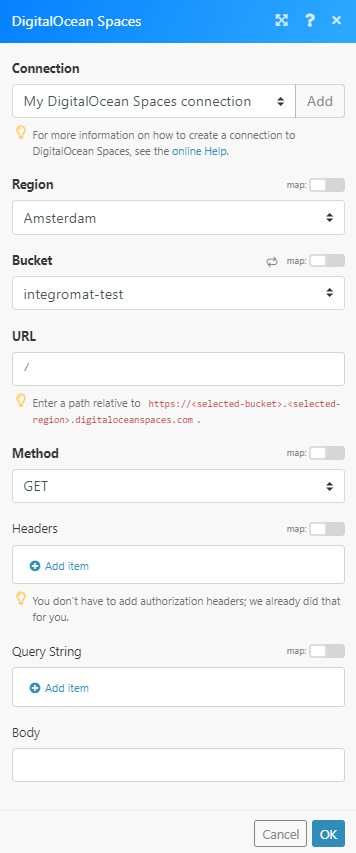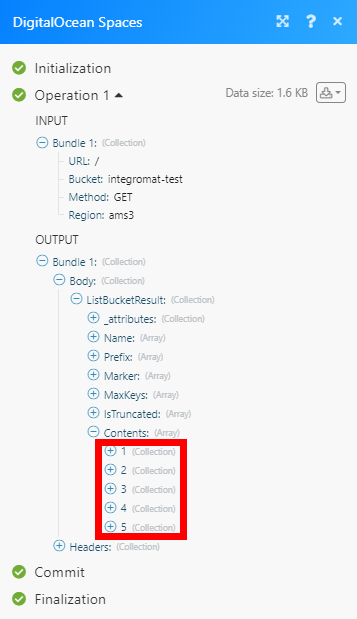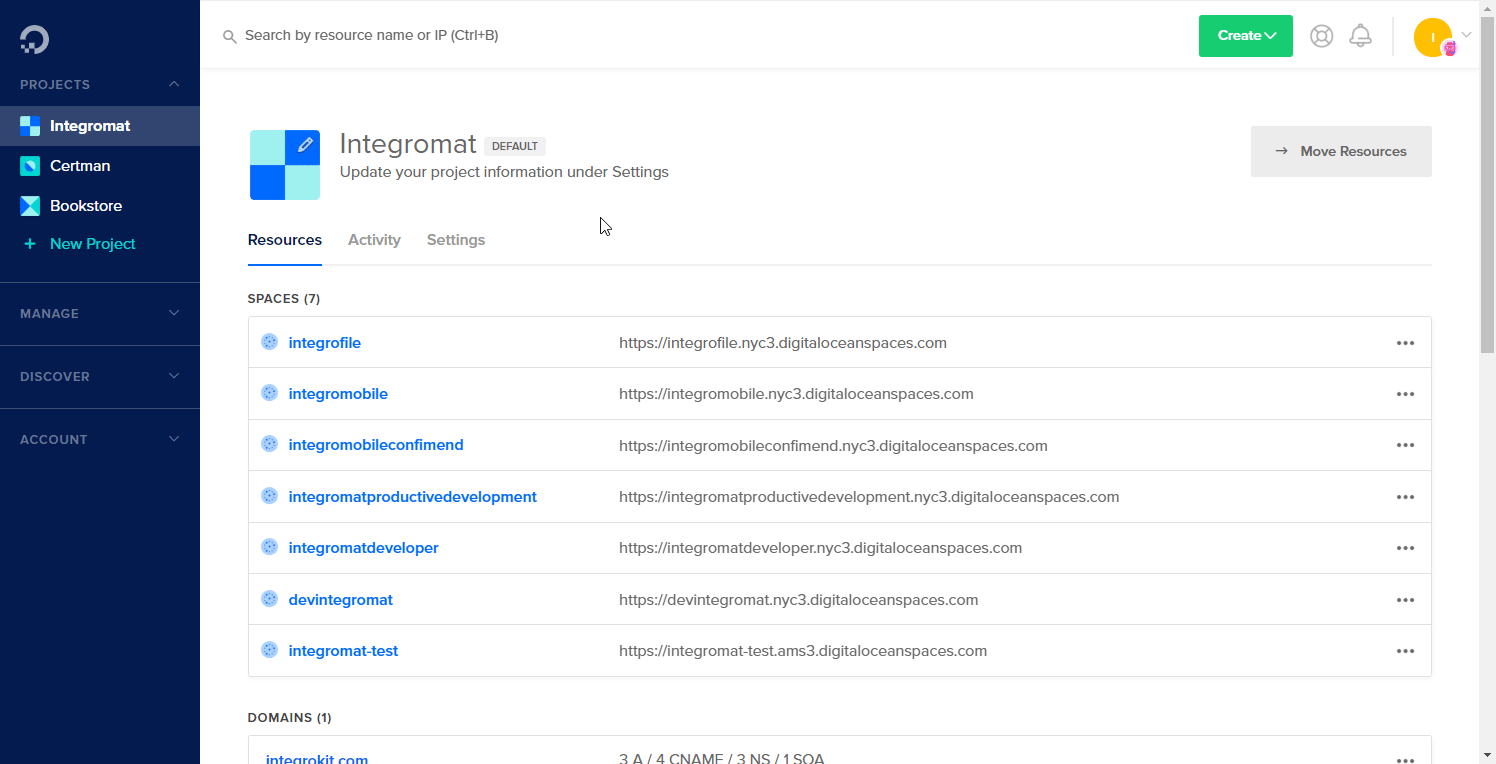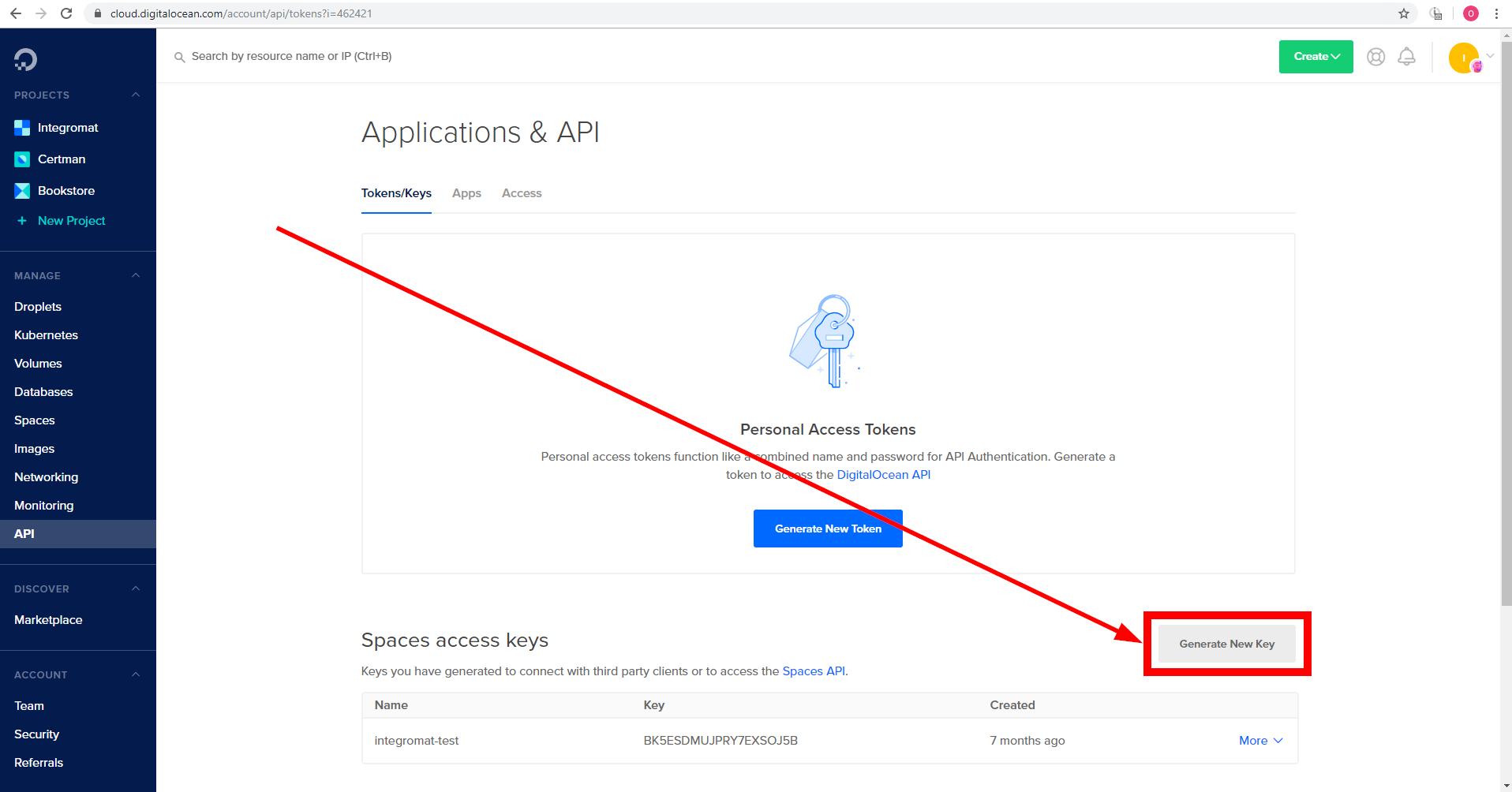| Active with remarks |
|---|
| This application needs additional settings. Please follow the documentation below to create your own connectionUnique, active service acces point to a network. There are different types of connections (API key, Oauth…). More. |
The DigitalOcean SpacesSubunits are created within modules to maintain organization and clarity, even with large amounts of data. More modulesThe module is an application or tool within the Boost.space system. The entire system is built on this concept of modularity. (module - Contacts) More enable you to monitor, list or create buckets and files in your DigitalOcean Spaces account.
Prerequisites
-
A DigitalOcean Spaces account
In order to use DigitalOcean Spaces with Boost.spaceCentralization and synchronization platform, where you can organize and manage your data. More IntegratorPart of the Boost.space system, where you can create your connections and automate your processes. More, it is necessary to have a DigitalOcean Spaces account. If you do not have one, you can create a DigitalOcean Spaces account at DigitalOcean website.
![[Note]](https://docs.boost.space/wp-content/themes/bsdocs/docs-parser/HTML/css/image/note.png) |
Note |
|---|---|
|
The moduleThe module is an application or tool within the Boost.space system. The entire system is built on this concept of modularity. (module - Contacts) More dialog fields that are displayed in bold (in the Boost.space Integrator scenarioA specific connection between applications in which data can be transferred. Two types of scenarios: active/inactive. More, not in this documentation article) are mandatory! |
To connect your DigitalOcean Spaces account to Boost.space Integrator you need to obtain the Access Key and Access Secret Key.
-
Log in to your DigitalOcean account.
-
Open the Manage > API section from the menu on the left.
-
Scroll down to the Spaces access keys section and click the grey Generate New Key button.
-
Enter the name for the new access key and press Enter.
-
Copy the provided Access Key and Access Secret Key.
-
Go to Boost.space Integrator and open the DigitalOcean Spaces module’s Create a connection dialog.
-
Enter the Access Key and Access Secret Key you have copied in step 5 to the respective fields and click the Continue button to establish the connection.
Returns the bucket’s name and creation date when the bucket is created in your account.
|
Connection |
|
|
Region |
Select the region you want to retrieve buckets from. |
|
Limit |
Set the maximum number of buckets Boost.space Integrator will return during one execution cycleA cycle is the operation and commit/rollback phases of scenario execution. A scenario may have one or more cycles (one is the default).. |
Retrieves all buckets in your account.
|
Connection |
|
|
Region |
Select the region you want to retrieve buckets from. |
|
Limit |
Set the maximum number of buckets Boost.space Integrator will return during one execution cycle. |
Creates a new bucket in the specified region.
|
Connection |
|
|
Name |
Enter the name for the new bucket. |
|
Region |
Select the region you want to create a new bucket at. |
Returns the file’s name, size, and date modified when the file is uploaded or updated in the bucket.
|
Connection |
|
|
Region |
Select the region that contains the bucket you want to watch for files. |
|
Bucket |
Select the bucket you want to watch for new or updated files. |
|
Prefix |
Enter the path you want to watch files at. |
|
Limit |
Set the maximum number of files Boost.space Integrator will return during one execution cycle. |
Retrieves all files in the specified bucket.
|
Connection |
|
|
Region |
Select the region that contains the bucket you want to list files from. |
|
Bucket |
Select the bucket you want to list the files from. |
|
Prefix |
Enter the path you want to list files from. E.g. |
|
Limit |
Set the maximum number of files Boost.space Integrator will return during one execution cycle. |
Downloads a file from the specified bucket.
|
Connection |
|
|
Region |
Select the region that contains the bucket you want to download the file from. |
|
Bucket |
Select the bucket you want to download the file from. |
|
Path |
Enter the path to the file you want to download E.g. |
Uploads a file to a bucket.
|
Connection |
|
|
Region |
Select the region that contains the bucket where you want to upload a file. |
|
Bucket |
Select the bucket you where you want to upload a file. |
|
Folder |
Enter the path of the target location. Leave empty to upload the file to the root of the bucket E.g. |
|
Source File |
Map the file you want to upload from the previous module (e.g. HTTP > Get a File or Dropbox > Get a file), or enter the file name and file data manually. |
|
Headers |
Insert headers if needed. See common headers or additional headers that can be used here. |
Allows you to perform a custom API call.
|
Connection |
||||
|
URL |
Enter a path relative to
|
|||
|
Method |
Select the HTTP method you want to use: GET to retrieve information for an entry. POST to create a new entry. PUT to update/replace an existing entry. PATCH to make a partial entry update. DELETE to delete an entry. |
|||
|
Headers |
Enter the desired request headers. You don’t have to add authorization headers; we already did that for you. |
|||
|
Query String |
Enter the request query string. |
|||
|
Body |
Enter the body content for your API call. |
The following API call returns all objects (files and folders) from the specified bucket:
URL:
/
Method:
GET

Matches of the search can be found in the module’s Output under BundleA bundle is a chunk of data and the basic unit for use with modules. A bundle consists of items, similar to how a bag may contain separate, individual items. More > Body > Contents.
In our example, 5 objects were returned:



